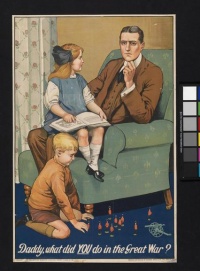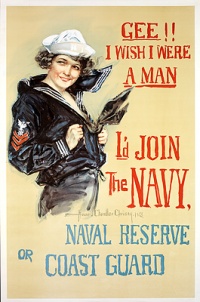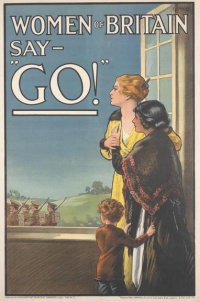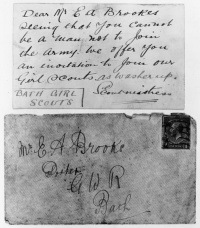The Militarisation of Masculinity before 1914↑
Was the First World War a turning point in the history of masculinity, witnessing the demise of old ideals of masculinity and the reconfiguration of gender relations? The interest in the war’s impact on men is relatively recent: only in the mid-1990s did historians of the First World War start to turn their attention to images of masculinity, ideals of manliness, and to male identities. An important stimulus for research was George Mosse’s (1918-1999) book-length essay The Image of Man (1996), which traced the relationship between masculinity and sacrifice back to the French Revolution. Differentiating Mosse’s claims, a number of studies on ideals of masculinity in the 19th century have since shown that in the early half of the 19th century the soldierly ideal of manliness was not yet dominant, but rather stood in competition with a range of other concepts of masculinity. Nearing the end of the 19th century, however, masculinity and militarism became intimately linked; this process intensified during the early years of the 20th century. By 1914 the ideal of martial masculinity seemingly had reached its apex: the war appeared to be a test of manhood, defined by courage, strength and the spirit of sacrifice, especially for young educated men across Europe. Even though war enthusiasm in 1914 was not as widespread as has long been assumed, but was rather a minority phenomenon, it was accentuated among university students and thus among a group that has been characterised as the main bearers of the male warrior ideal.
The intense militarization of German imperial society has long been interpreted as a German particularity, part of the German Sonderweg into modernity. In the last twenty years a range of comparative studies, as well as detailed studies on France and Britain, have challenged this view and shown comparable processes in these countries. The increasing militarisation of masculinity in fin-de-siècle Europe can be interpreted as a consequence of gender anxieties caused by the first wave of feminism and its challenge to male dominance, but also as a reaction to fears of degeneration and national decline that pervaded European societies in the early years of the 20th century. In the controversial debate about the causes of war in 1914 there is no consensus about the impact of popular bellicism and with it of militarised masculinity on the decision makers who led Europe into war.
Gender and the Front Experience↑
What happened to the ideal of the manly hero between 1914 and 1918? The current state of research suggests that the war experience had ambivalent consequences for ideals of manliness. In the early phase of the war, the relationship between soldiering and masculinity in public discourse became more entwined. Volunteers were celebrated in all combatant nations as ideals of masculinity, while recruiting posters depicted soldiers as models of manliness. Men who could or would not fight were often depicted as effeminate. Symbolic strategies, such as British women handing white feathers to men of military age not in uniform, served to publicly denounce them as unmanly.
Moving beyond public discourse, soldiers’ letters from the front, war diaries and post-war accounts of war experiences show a multiplicity of experiences that could either stabilize or destabilize male identities. While it seems difficult to establish patterns, it appears that soldiers’ ideas of martial masculinity, rather than being destroyed, slowly changed during the four years of conflict: endurance and the ability to suffer became as important for defining the manly soldier as courage and strength. As with most aspects of wartime masculinity, the effect of men being “away” at the front and spending long periods of time in an all-male community has been interpreted in two ways: on the one hand, soldiers’ letters from the front and war diaries describe intense experiences of male bonding that sometimes included intimate gestures such as kisses among men. To some degree male bonding superseded differences of class and regional origin among soldiers. Both the actual distance between the front and “home” and the experience of battle, which to many seemed impossible to convey to non-combatants, caused feelings of detachedness from the home front, from civilian life and from women. On the other hand, it is quite clear that cleavage between the (masculine) fighting front and the (feminine) home front was never absolute and the war caused no unbridgeable chasm either between men and women or between pre- and post-war male identities. Despite the intense militarization of masculinity in early 20th century Europe, other aspects of male identity beside that of the soldier continued to be of importance: soldiers continued to be sons and husbands, they stayed in close contact with families and made plans for their return home. In line with a growing body of research that relativizes the ruptures brought about by the war, recent literature highlights the relative stability of male identities when faced with the challenges of combat.
Masculinity in wartime was closely associated with violence; soldiering meant not only suffering and dying, but also killing. Historians have shown that men, as well as women, could find pleasure in killing. Yet most men who returned home longed for a return to domesticity. Even in Germany, where the ideal of the warrior after 1918 dominated public discourse, only a minority of men chose to continue fighting after the war ended by joining the Free Corps movement. Both in Germany and in fascist Italy, it was once again young educated men who identified most closely with the ideal of martial masculinity. A process of “brutalization” can thus be attributed to public discourse – as in Italy and Germany – but not in a generalized way to male behaviour.
The most concrete impact of war on men was the mutilation and “dismemberment” of male bodies. Not only shell-shocked soldiers had to come to terms both with social expectations and with their personal self-images as men. Even though mutilated veterans were presented as war heroes in official discourse after 1918, many experienced their disability and enforced passivity as emasculating. Their inability to earn their own livelihoods or to support their families coupled with their dependence on often meagre state rent conflicted with both social and personal expectations. Some forms of mutilation were also emasculating in the most literal sense and caused problems in marriages.
The War’s Repercussion on Manliness↑
In post-war literature, Ernst Jünger’s (1895-1998) diaries are paradigmatic for those who praised the battle as the testing ground and incarnation of male identity. The warrior became the embodiment of masculinity, with violence one of its core ingredients. There were, however, other interpretations, too: in the works of the British “war poets”, such as Siegfried Sassoon (1886-1967), Edmund Blunden (1896-1974), Wilfred Owen (1893-1918) and Robert Graves (1895-1985), the war appears as a crisis of masculinity. Trench warfare in their writings was associated with trauma and disillusionment; the slaughter from mechanised warfare exposed the heroic ideal of manliness as an “old lie”. It was through the works of the war poets that this interpretation became highly influential in 1920s Britain, coexisting in a somewhat uneasy way with a continuing public celebration of sacrifice and martial masculinity. British pacifists, particularly in the late 1920s and early 1930s, contributed to the continuation of the disillusionment-narrative, and British historians have long described it as “the” reaction of British soldiers to the war. In recent years, however, it has become clear that this was probably a minority reaction, albeit one with a significant impact on post-war society.
It is in large part due to the influence of the British war poets that trauma, shell shock, and its implications for male identity became an important topic in British society and in historical writing. In 1985, Elaine Showalter argued in an influential study that passivity in the trenches “feminised” men. This supposedly “female” experience of powerlessness clashed with the dominant ideal of the male warrior, and within this clash lay the main cause of shell shock. The war thus led to “a crisis of masculinity” and the “breakdown of the Victorian masculine ideal”. However, recent scholarship tends to question the interpretation of the war as a “crisis of masculinity”. It is questionable if it was really the gap between male expectations and reality that caused shell shock, or rather the physical and psychic strain of trench warfare. Still, gendered expectations played an important role in both the soldiers’ attempts to come to terms with their illness and in social reactions, which again varied along national lines: while German psychiatrists tended to judge neurotic patients and their fears as unmanly, French and Russian war psychiatrists were more likely to define fear as an acceptable part of soldiers’ masculinity.
Trauma and disillusionment as aspects of a crisis of masculinity were to some extent also present in post-war German discourse and are generally associated with the works of Otto Dix (1891-1969) and Erich Maria Remarque (1898-1970). Public discourse, heavily influenced by right-wing political groups, not only continued to centre around the cult of the manly soldier, but even took it to new extremes. Thus the impact of the war on the ideal of the manly warrior varied along national lines, with Germany and fascist Italy representing cases of a radicalization of the cult of military masculinity.
Masculinity and Gender Relations after the War↑
Women’s changing roles caused pervasive fears of a masculinisation of women and of a blurring or breakdown of established gender hierarchies in all combatant nations. While some men greeted the changes as an opportunity to recast the relationship between the sexes, the most common reaction was to defend male dominance. With men returning from the front, women were forced out of jobs and back into the domestic sphere. Yet despite these measures, which have been interpreted as the reconstruction of patriarchy after the war, gender relations and norms of masculinity did not simply return to the pre-war status quo. The war did not destroy old ideals of masculinity, but it brought multiple transformations within both public discourse and male self-perceptions.
Sonja Levsen, Albert-Ludwigs-Universität Freiburg
Section Editor: Emmanuelle Cronier
Selected Bibliography
- Audoin-Rouzeau, Stéphane: La Grande Guerre et l’histoire de la virilité, in: Corbin, Alain (ed.): Histoire de la virilité, volume 2, Paris 2011: Seuil, pp. 403-410.
- Bourke, Joanna: Dismembering the male. Men's bodies, Britain and the Great War, Chicago 1996: University of Chicago Press.
- Loughran, Tracey: A crisis of masculinity? Re-writing the history of shell-shock and gender in First World War Britain, in: History Compass 11/9, 2013, pp. 727-738.
- Showalter, Elaine: The female malady. Women, madness, and English culture, 1830-1980, New York 1985: Pantheon Books.
- Thébaud, Françoise: La Grande Guerre. Le triomphe de la division sexuelle, in: Duby, Georges / Perrot, Michelle (eds.): Histoire des femmes en Occident. Le XXe siècle, volume 5, Paris 1992: Plon.











